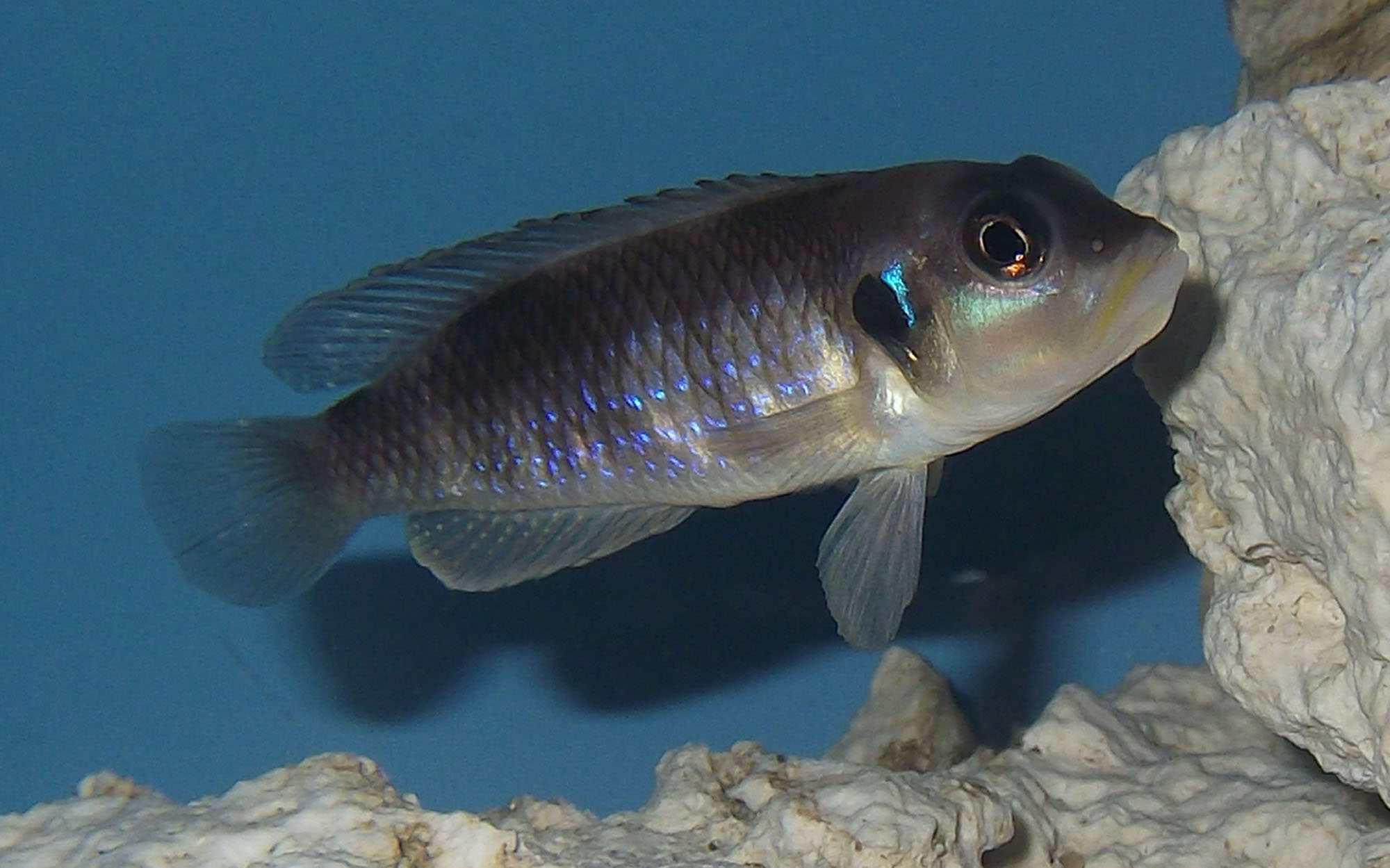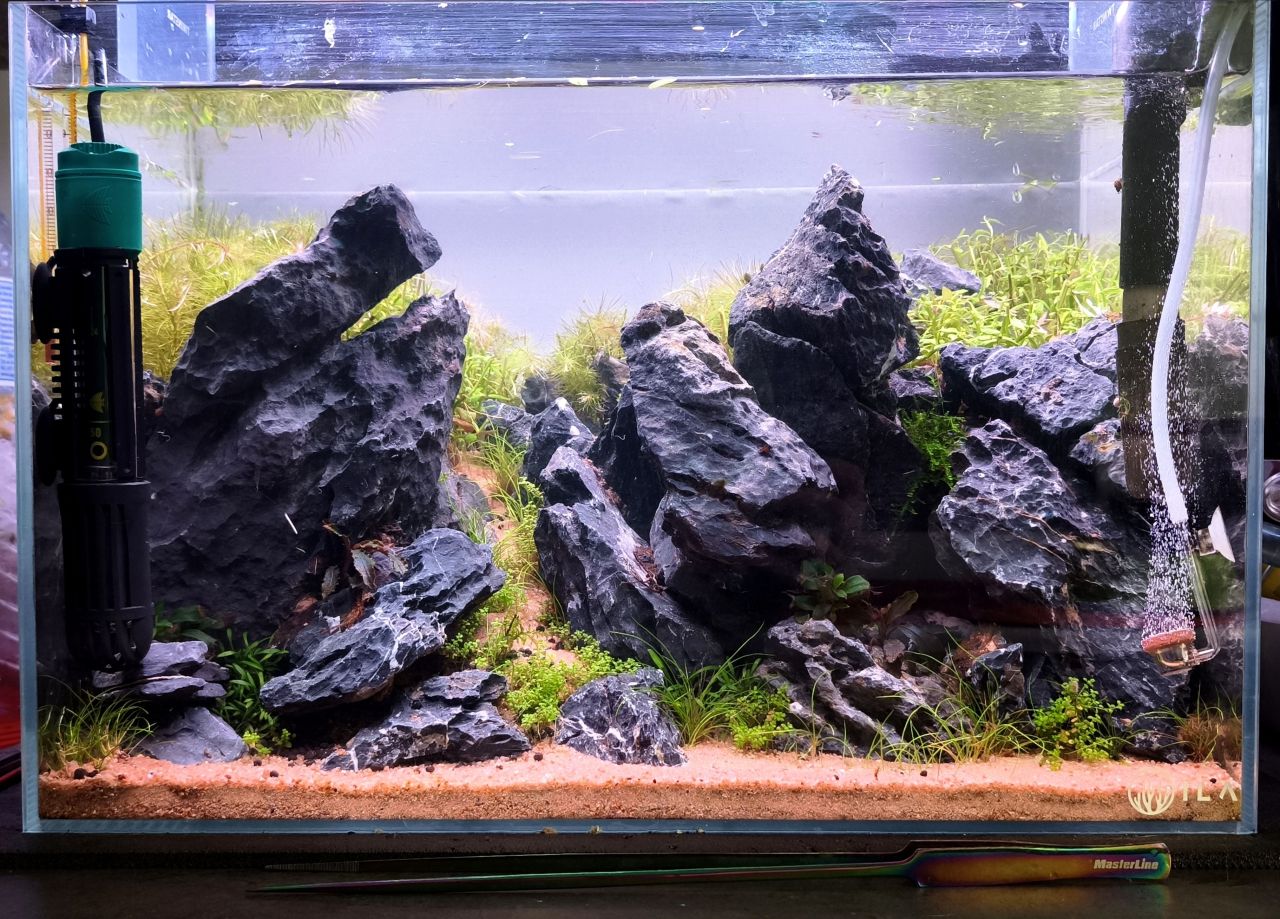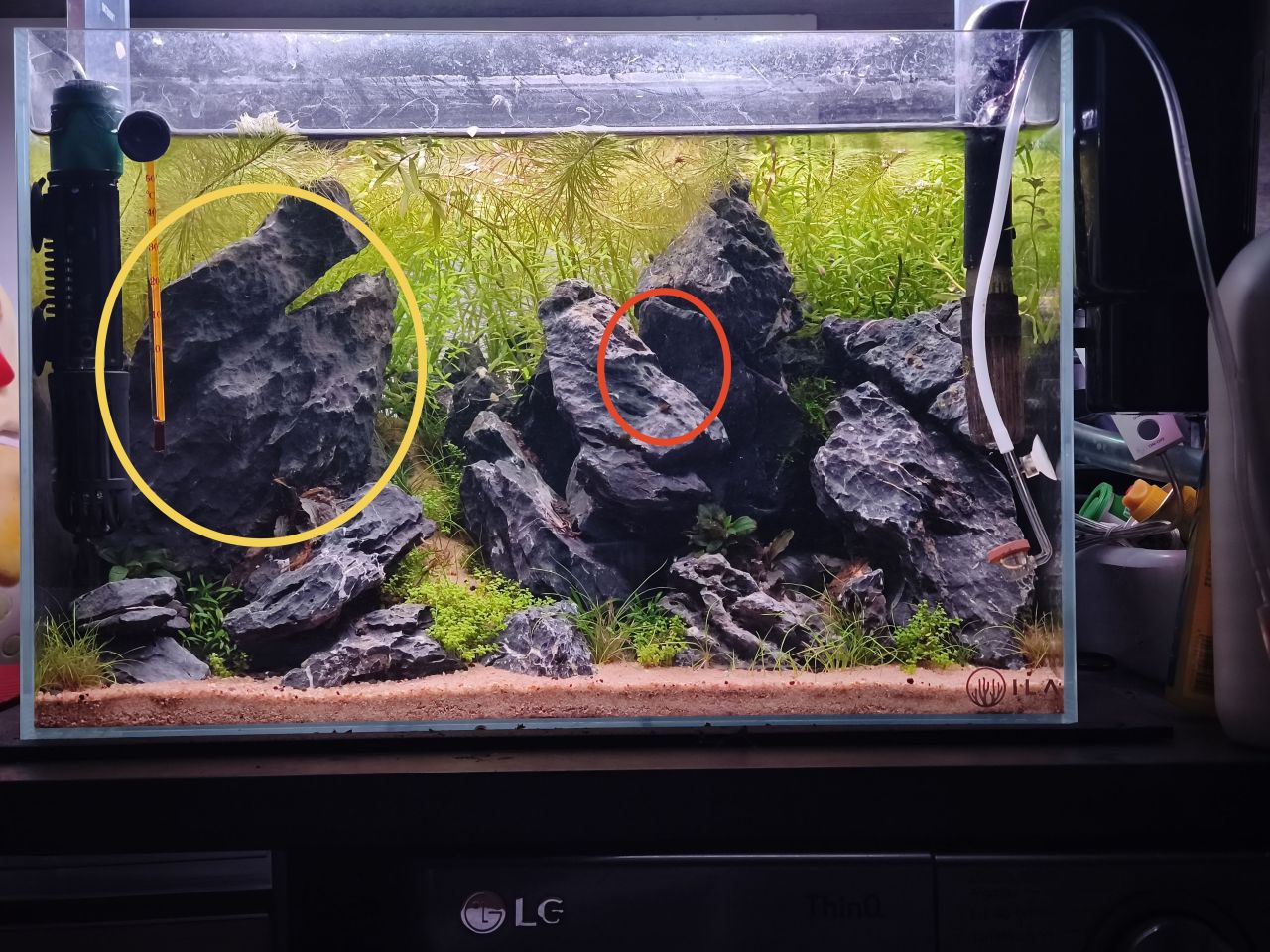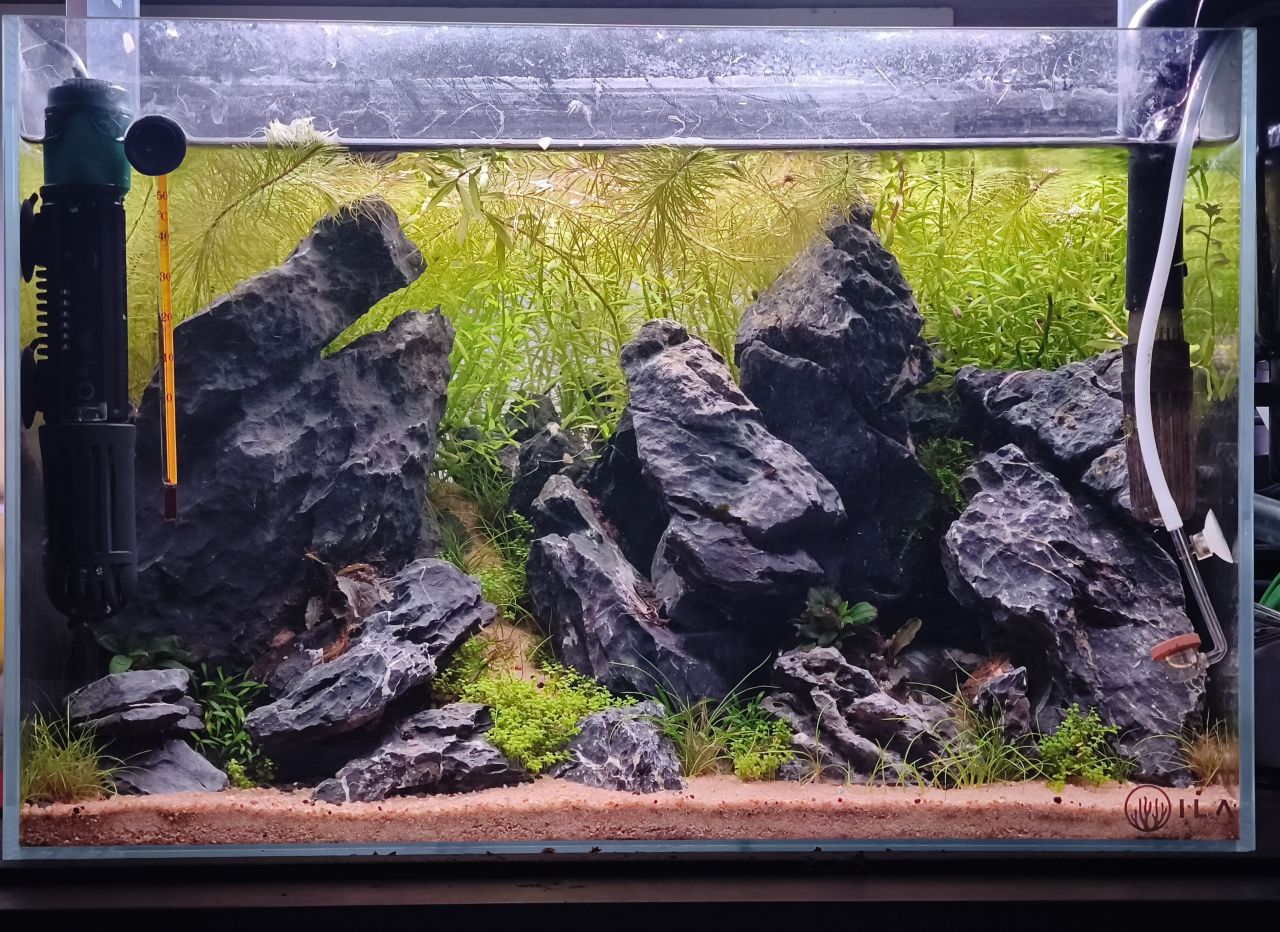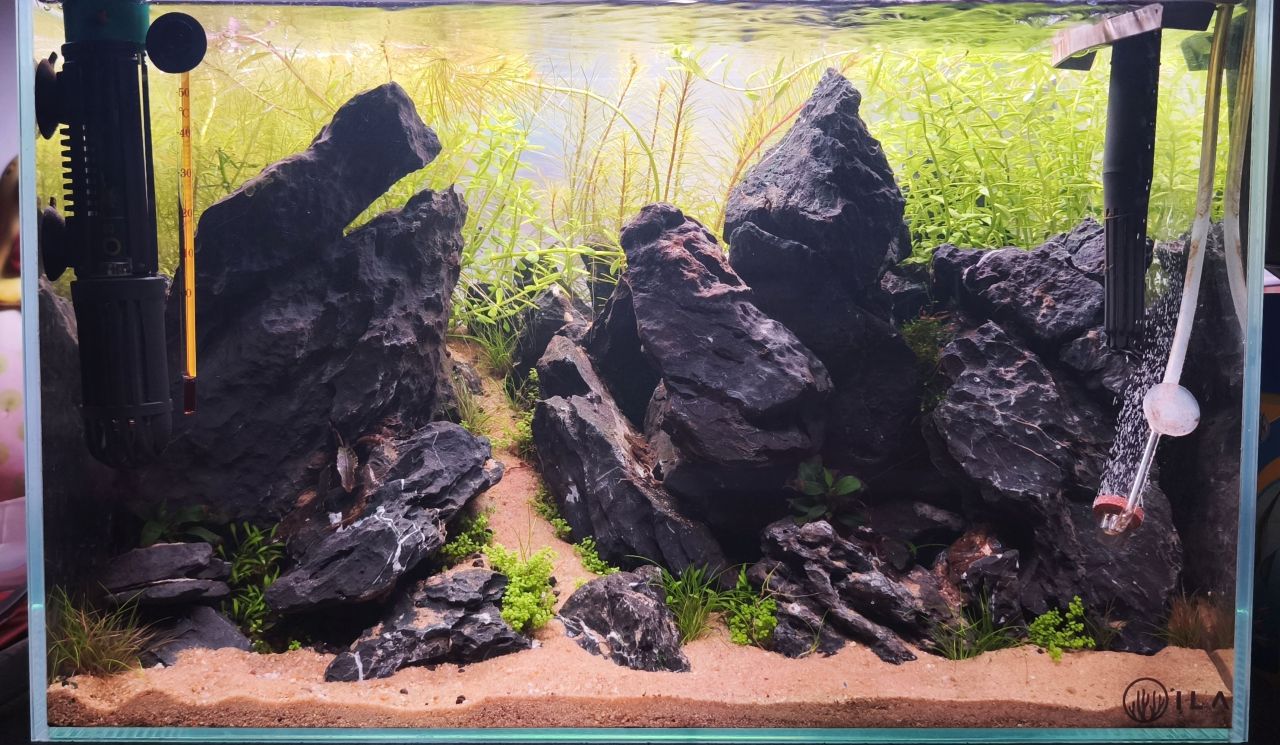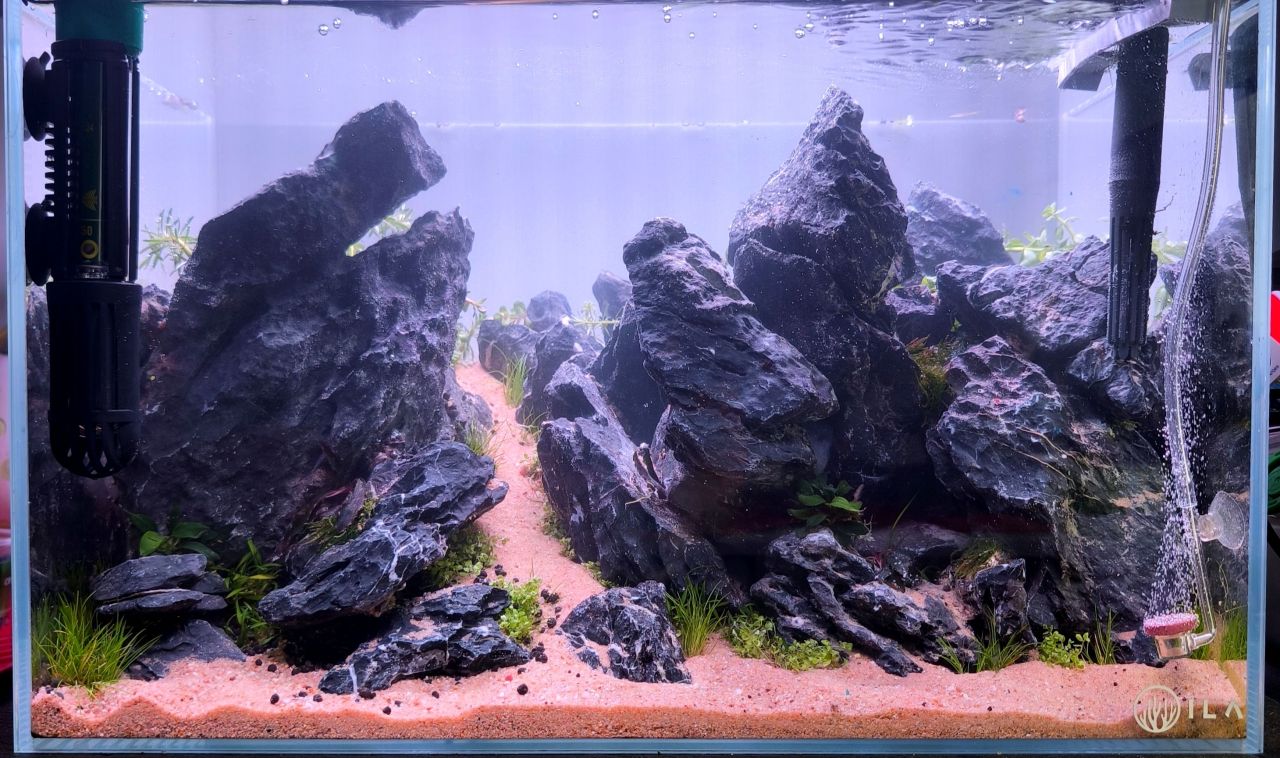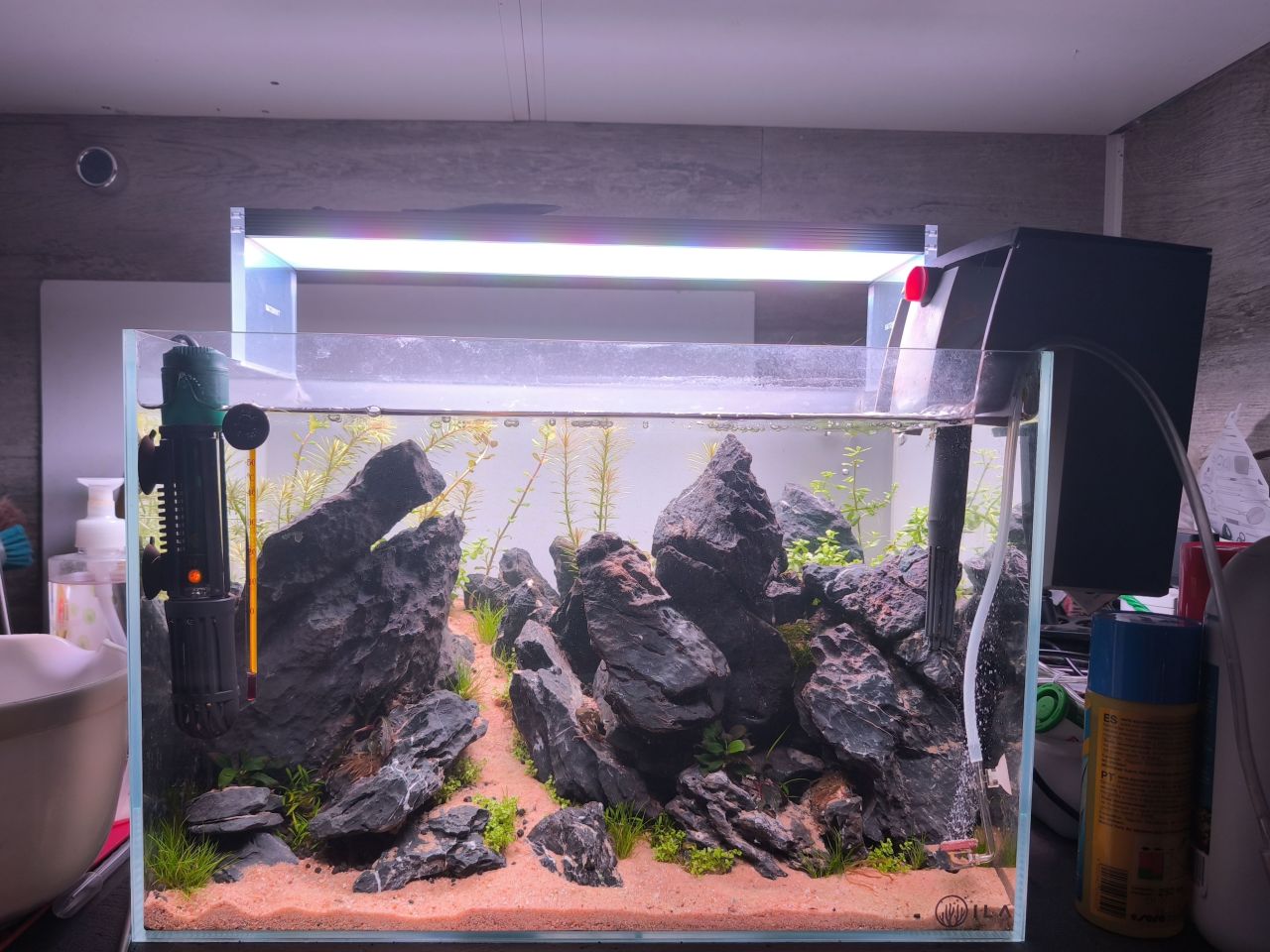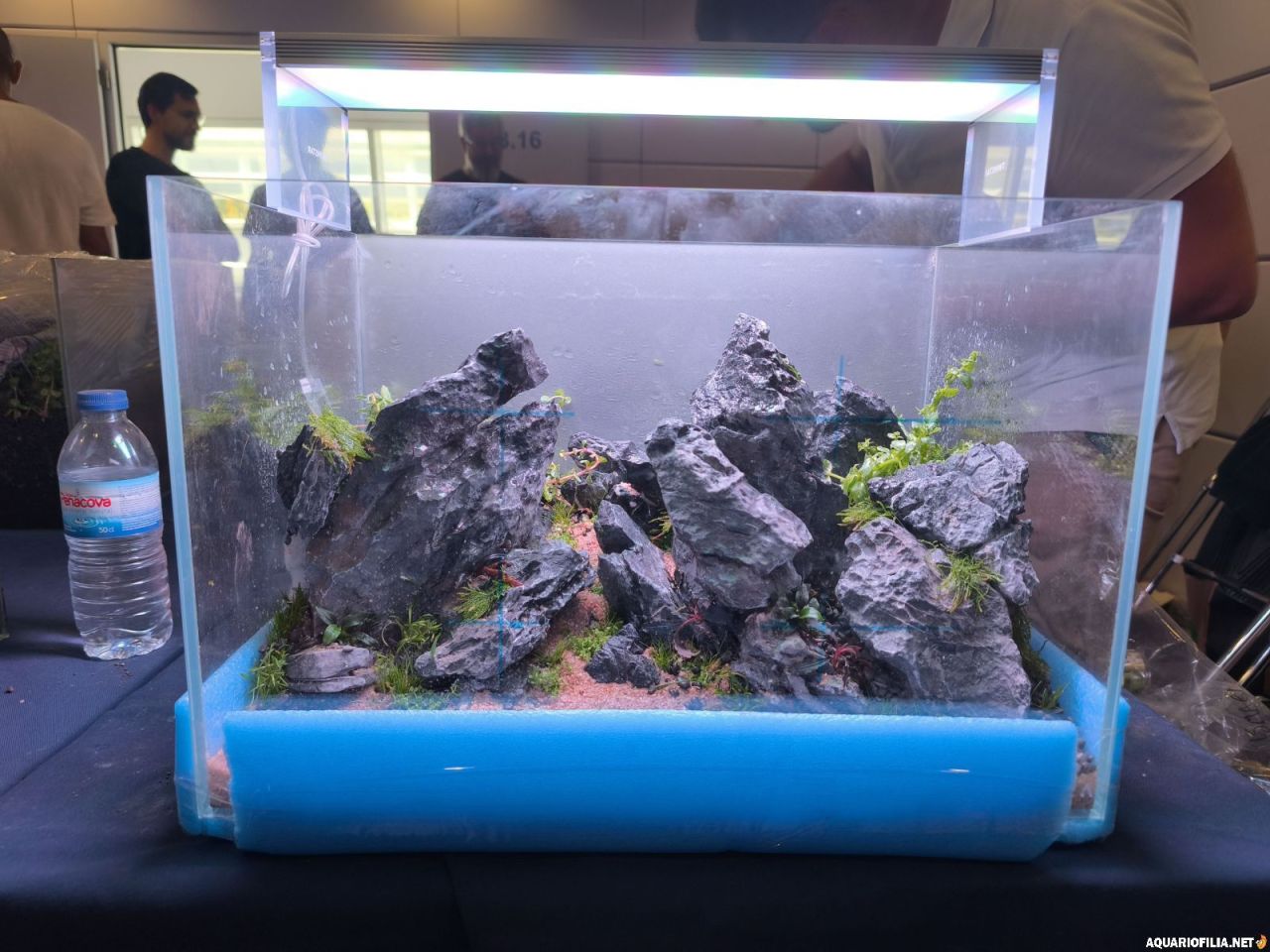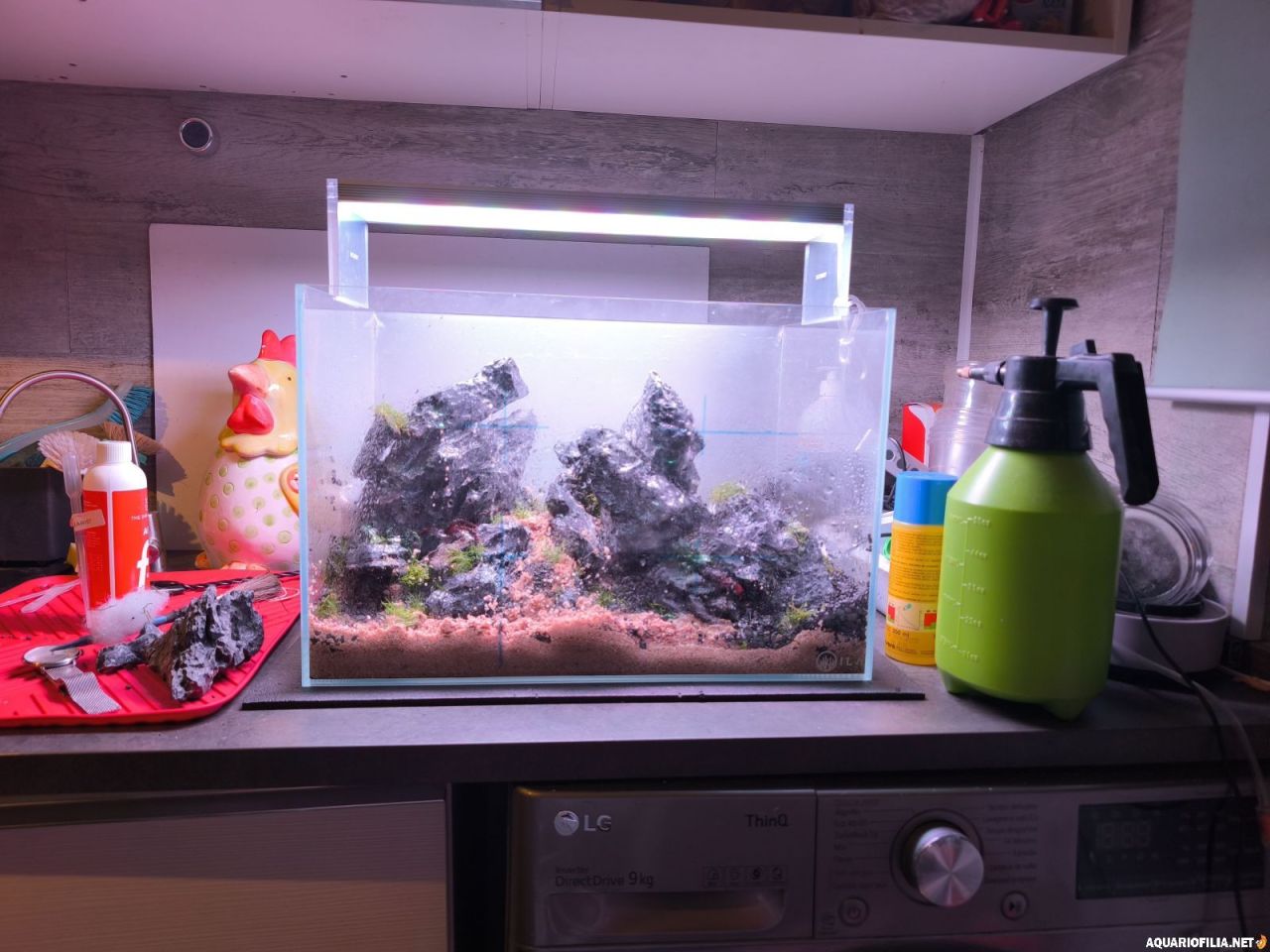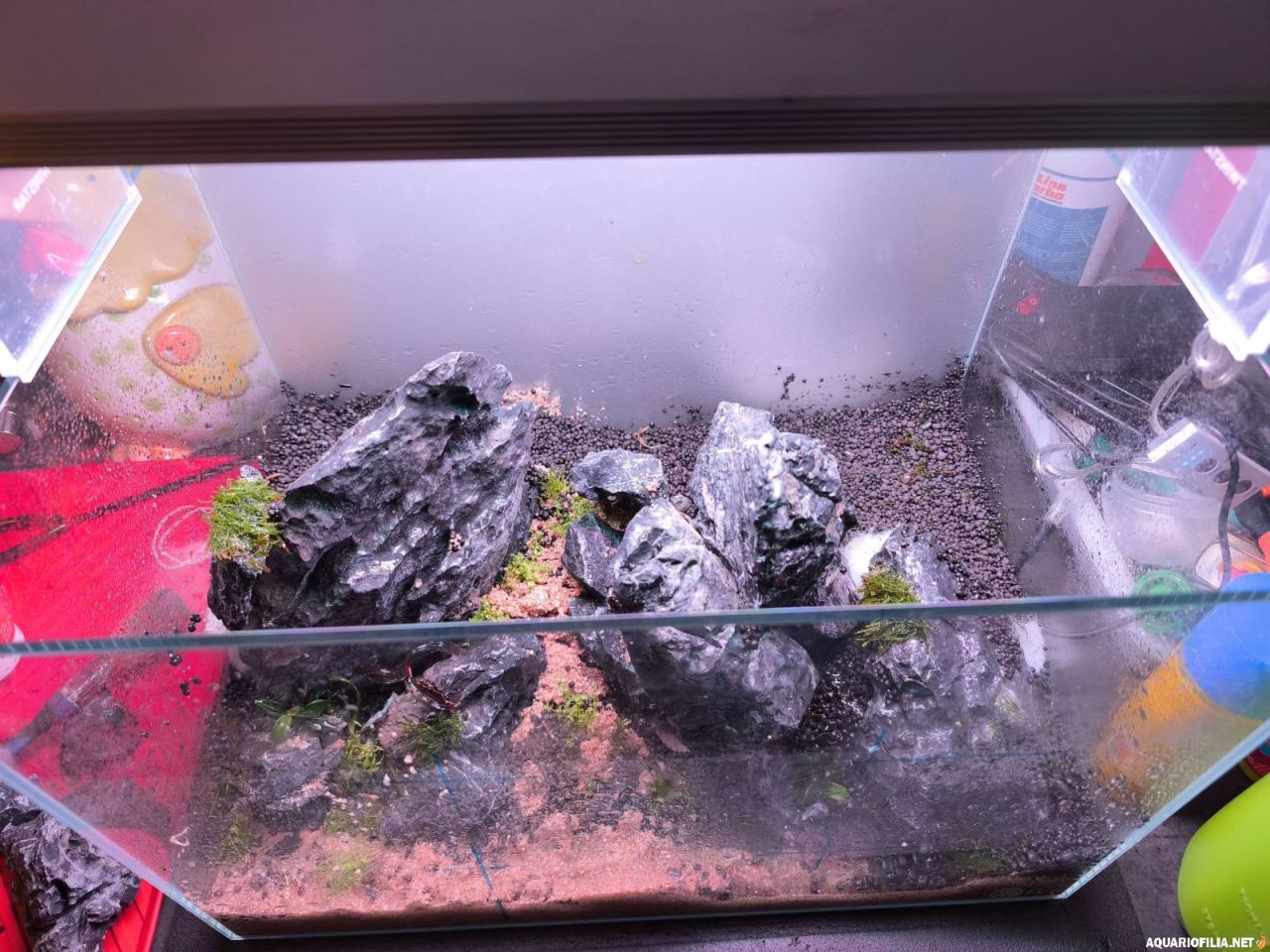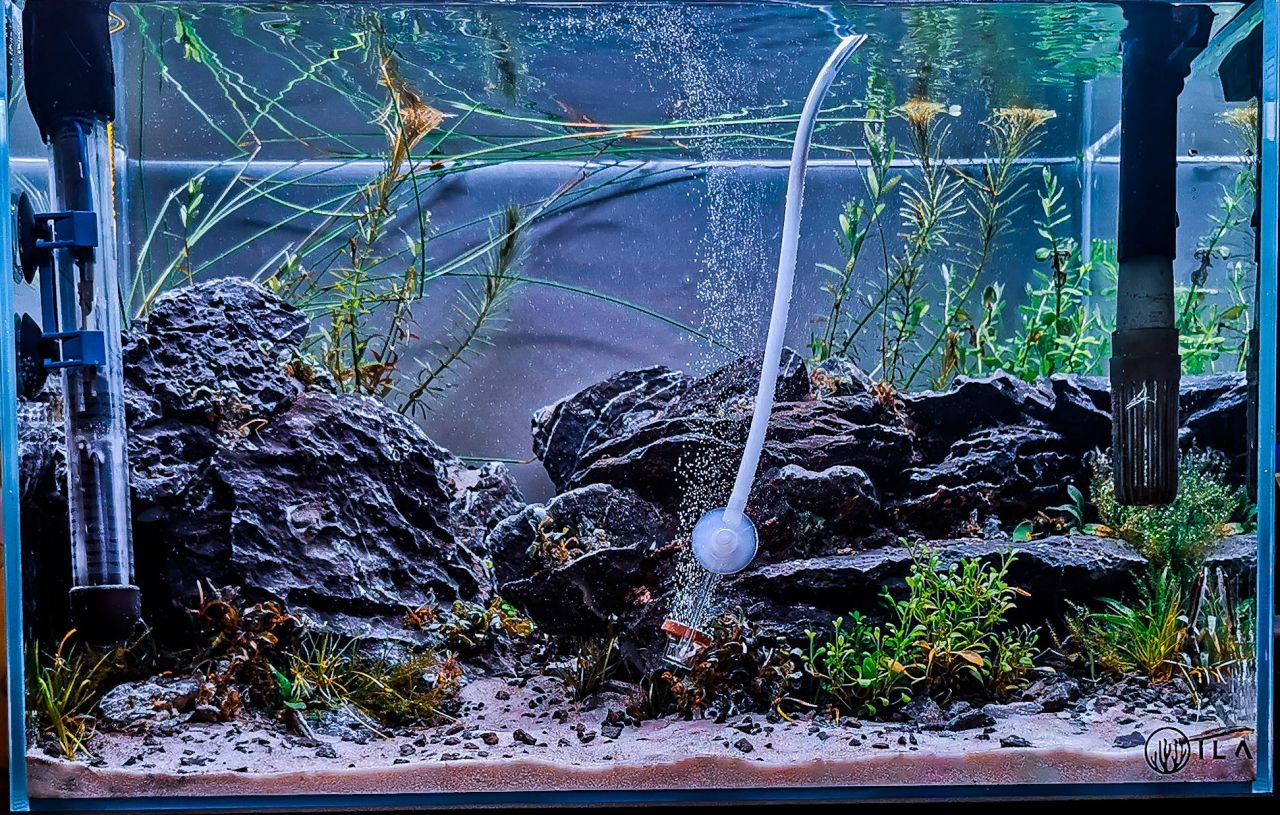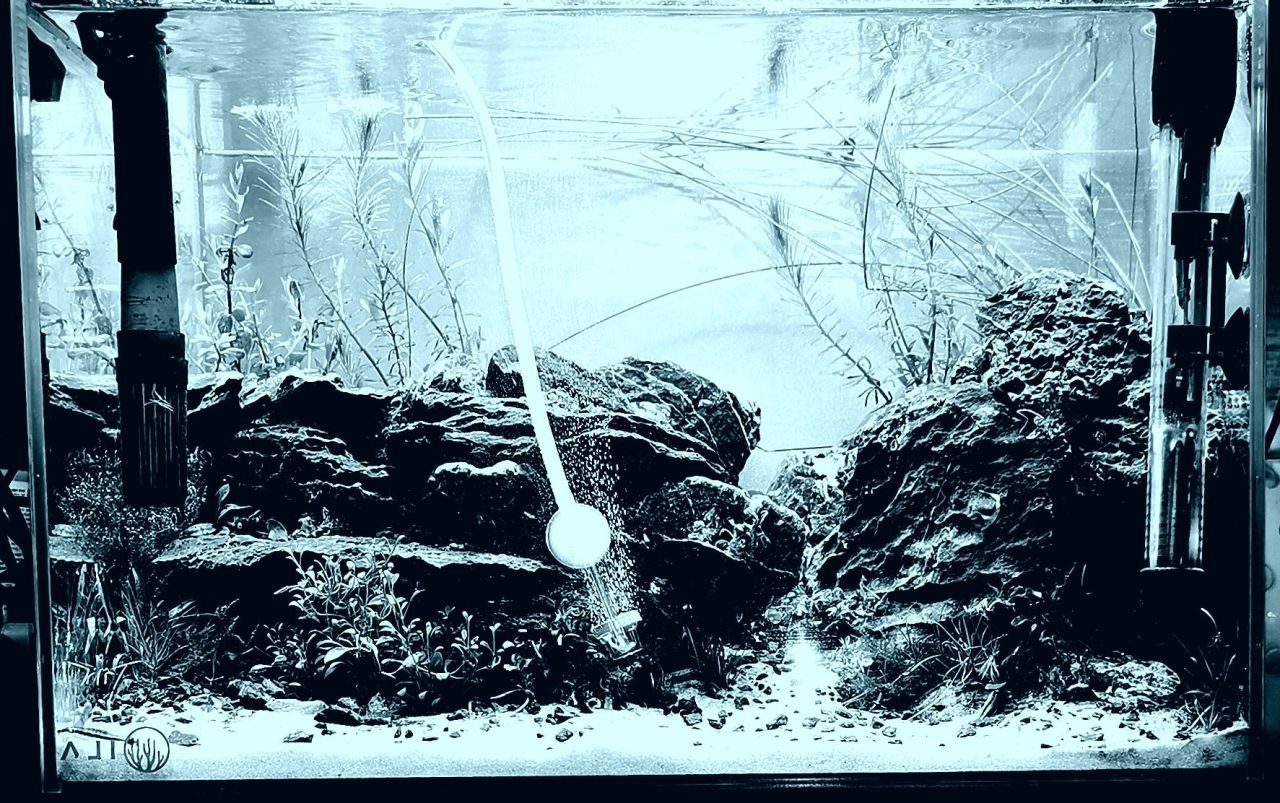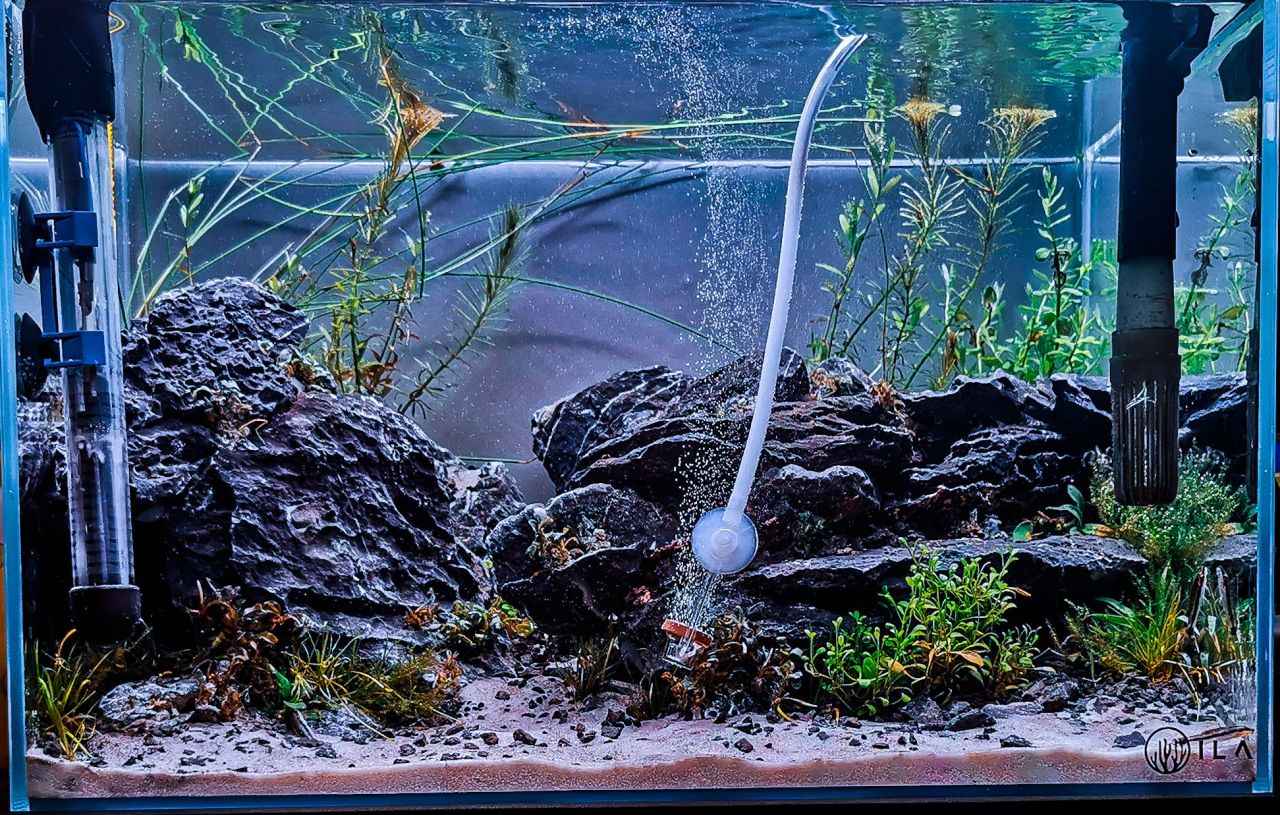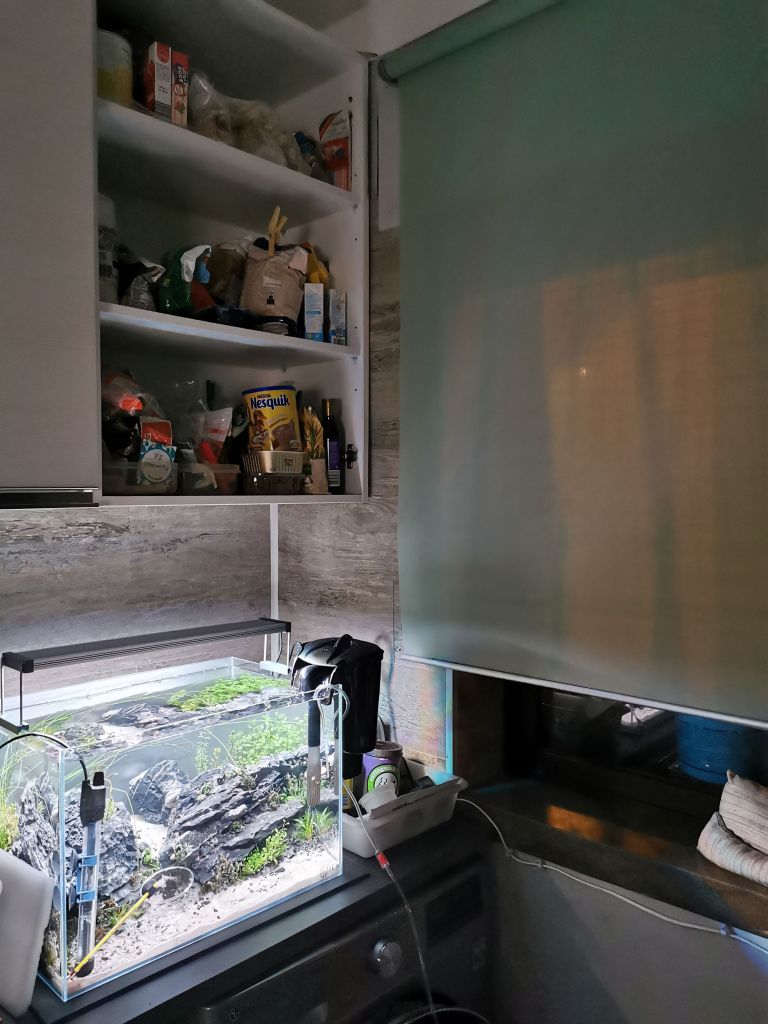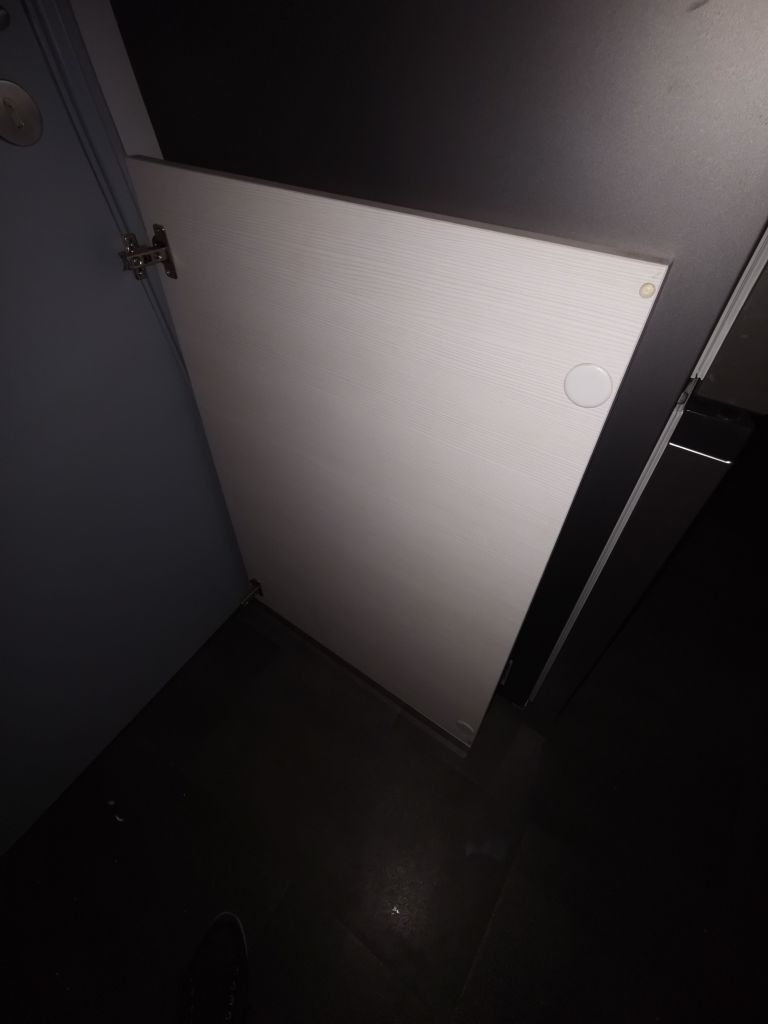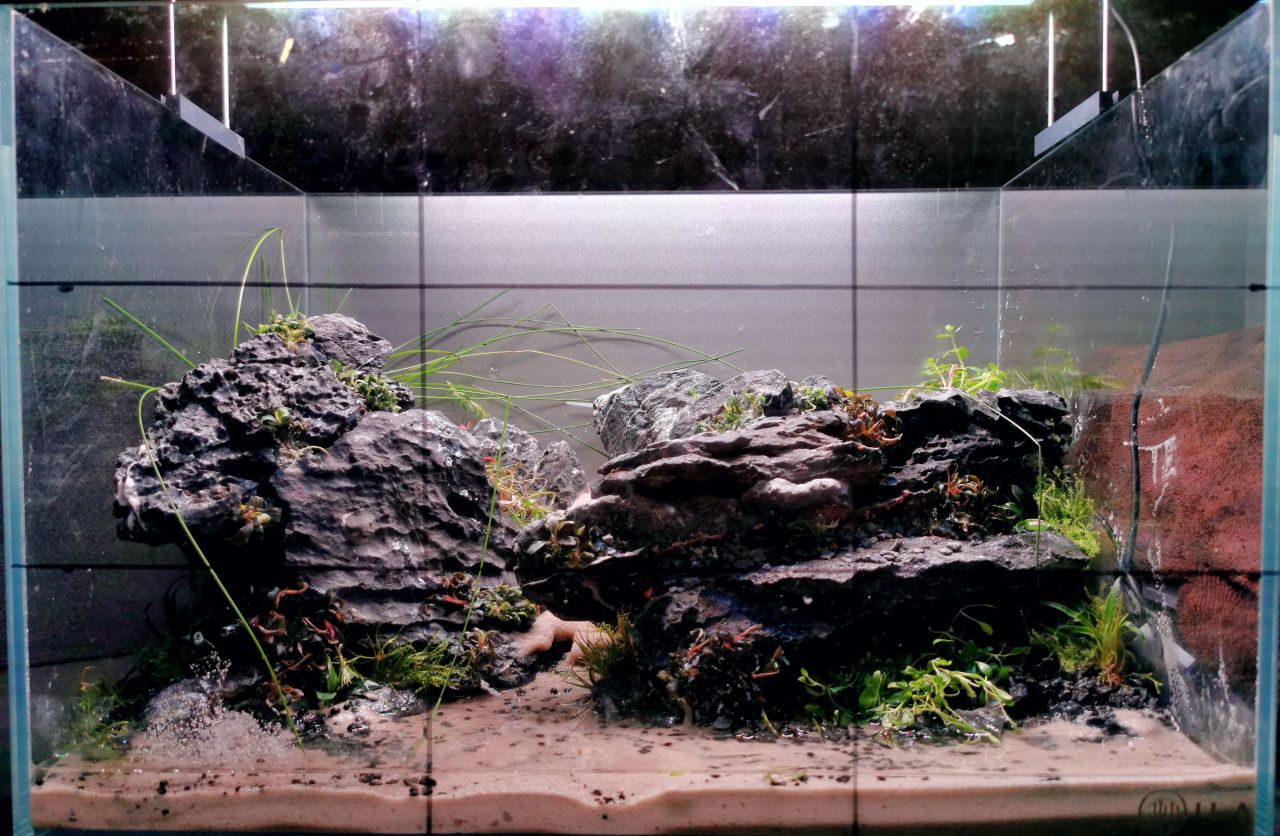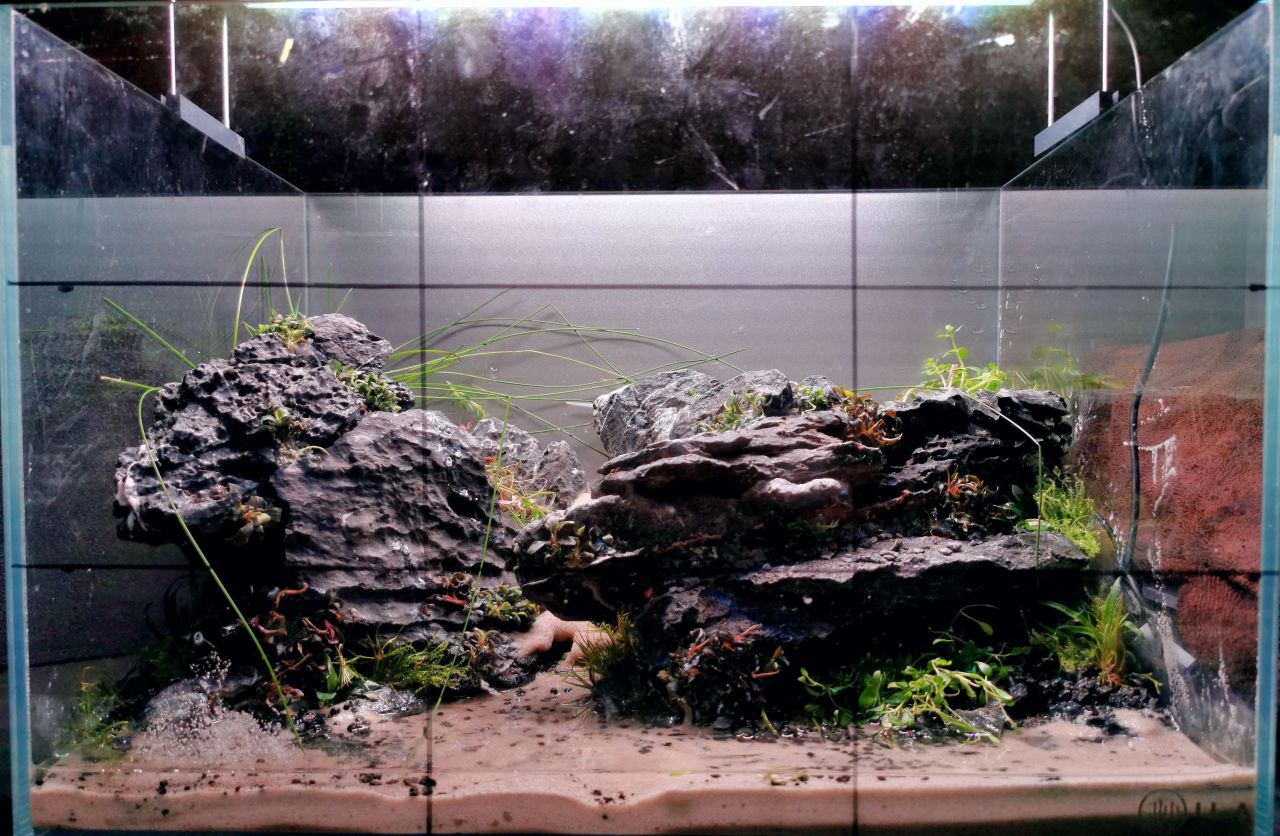Tipo de Conteúdo
Perfis
Fóruns
Eventos
Galeria
Downloads
Loja
Classificados
Community Map
Vídeos
Books
Tudo publicado por Vera Santos
-

[desafio] No name yet-VI Desafio de aquascaping
Vera Santos respondeu a Vera Santos num tópico de AQUASCAPING
Boas, aqui fica a actualização, poda feita mesmo agora, já dá para perceber, mais alguma coisa, dá Freire? Tem ali Uma rocha a meio que tenho de desenterrar um pouco mais para se ver de frente na foto. Ora timmer programado de seis para oito horas diárias. Ups vou lá fertilizar que me esqueci 🤣🤣 -

[desafio] No name yet-VI Desafio de aquascaping
Vera Santos respondeu a Vera Santos num tópico de AQUASCAPING
Boas, era para ser hoje....mas estou com uma do caraças...a ver se é amanhã. -

[desafio] The Dangerous Path - VI Desafio de Aquascaping Aquariofilia.net
Vera Santos respondeu a gjsilva num tópico de AQUASCAPING
Está a ficar composto, tenta escovar as rochas, deixares algum verdete também não tem mal nenhum, ficar mais natural... -

[desafio] Undecided - VI Desafio Aquariofilia.net
Vera Santos respondeu a Carlos Carvalheira num tópico de AQUASCAPING
Olha, não era má ideia expementares e veres se gostas mais, eu tento sempre esconder os cantos. Nem me lembrei desse pormenor ai ver a foto. -

[desafio] No name yet-VI Desafio de aquascaping
Vera Santos respondeu a Vera Santos num tópico de AQUASCAPING
Percebo o que dizes, refereste a onde exatamente? Acrescentar plantas onde? No vermelho posso acrescentar musgo,esteve lá anubias meltaram o amarelo é uma rocha unica, tinha colado plantas mas meltaram, cuba e anubias, não há muito por onde fazer, a não ser um pouco de musgo também e mais anubias. Lá atrás há uma rocha que não se vê sem poda. Tirei uma foto hoje, está tipo selva, o bom é algas zero, o co2 acabou no fim de semana, e como é habitual esqueço-me sempre de fertilizar 😅 Quinta feira faço poda e actualizo. -
Mais um aqui, fico contente de arranjares tempo para isso Gosto muito do layout. A acompanhar.
-
Boas, bem vindo novamente, está ficar porreiro, essas rochas são muito interessantes. A acompanhar.
-

[desafio] Desafio VI - Wooden Throne
Vera Santos respondeu a Vasco Ferreira num tópico de AQUASCAPING
Também gostava de ver o resultado dessa junção, vais misturar as duas para agarrar melhor ou não? Está a evoluir muito bem. -

[desafio] Frame - VI Desafio de aquascaping do fórum aquariofilia.net 25/26
Vera Santos respondeu a Fernando Freire num tópico de AQUASCAPING
Boas, está a ficar muito giro, concordo com o Ismael. Está muito vermelho no mesmo local, tens de fazer a transição de cor para não chamar demasiado a atenção do olhar. -

[desafio] Undecided - VI Desafio Aquariofilia.net
Vera Santos respondeu a Carlos Carvalheira num tópico de AQUASCAPING
Boas por agora estou a gostar do resultado, a poda atrás do lado direito ficou boa. Bela foto! -

[desafio] Afloramento - VI Desafio Aquariofilia.net
Vera Santos respondeu a José Pedro num tópico de AQUASCAPING
Boas, ainda bem que finalmente está a ir so sítio, Vai acabar tudo em ordem. -

[desafio] No name yet-VI Desafio de aquascaping
Vera Santos respondeu a Vera Santos num tópico de AQUASCAPING
Boas, quanto á cor da areia não me choca muito, é uma mistura que fiz, com o passar do tempo, aspiração e tal posso juntar mais clara talvez. Hoje está assim, a precisar de uma segunda poda. Talvez faça amanhã. -

[desafio] Desafio VI - Wooden Throne
Vera Santos respondeu a Vasco Ferreira num tópico de AQUASCAPING
Boas, gostei imenso do layout, algo diferente ao que nos tens habituado, ao vivo então, estava muito bom, nem precisava de água e era um lindo terrário 🤣...mas não pode ser! Está a evoluir bem, estou a gostar do que vejo. Também não tenho fertilizado o meu, mas pensas fazê-lo? Beijinhos -

[desafio] Shattered Peaks - VI Desafio Aquiriofilia.net
Vera Santos respondeu a heyplanche num tópico de AQUASCAPING
Boas, gostei do layout, a única coisa que vejo que pode ser melhorada e dar algum contraste seria a retirada de parte dos pedriscos, colocares areia e alguns pedriscos por cima. Acho sinceramente que ia ganhar mais cor e luminosidade. É uma coisa que podes fazer, não é considerada uma alteração significativa, tens é de ter paciência para fazer, também não demora muito. A acompanhar 😉 -

[desafio] No name yet-VI Desafio de aquascaping
Vera Santos respondeu a Vera Santos num tópico de AQUASCAPING
Boas, prometi foto de como ficou o aquário depois de reconstruído e não havia meio, então aqui fica a foto. Em parte consegui chegar ao que estava, mas desde logo ressalta á vista uma coisa que detesto e que inicialmente não acontecia, o caminho parece uma autoestrada, demasiado recto. É um cuidado que tenho sempre, mas claro que falhei ao refazer o layout. Vou ter que tentar disfarçar isso com plantas. Aqui fica uma foto de 6 de Outubro. Já se vê um crescimento das plantas, ainda sem fertilização. Fico a dever foto actual mas o aquário a esta hora já está apagado, a ver se o faço amanhã. Abraços -
VI Desafio de aquascaping (2025) Mais um ano mais um desafio, um dia muito bem passado e divertido. É sempre bom rever amigos e conhecer outros. O dia correu optimamente, montagem de hardscape, desta vez não usei espuma, "my bad", foi todo colado com cianocrilato, o transporte correu bem até casa, o problema foi mesmo ao po-lo no lugar final. Ao retirar o aquário de dentro da embalagem, o meu amigo que me estava a ajudar inclinou o aquário e a montagem desmoronou. No dia seguinte, mais á obra, e como queria que ficasse realmente idêntico, passei cerca de 5h a completar o puzzle. Depois no dia seguinte plantei, mais ou menos como estava, tinha guardado as plantas num balde com água, e claro estavam misturadas, o que não tem problema porque se vai acertando conforme as plantas crescerem. Contratempo superado. No meio disto tudo, a sorte é que tinha tirado duas fotos no dia da montagem lá na Fil, embora já tivesse posto o invólucro por debaixo do aquário. Senão tivesse tirado a foto estava tramada, não iria ficar como previsto. 1 - Nome do Aquário Mais para a frente com o desenvolvimento do aquário escolherei o nome, conforme é habitual em todos os aquários aqui em casa. 2 - Data da montagem 28/9/2025 3 - Dimensões do aquário ILA 45x30x30extra-claro, colagens invisíveis! 4 - Equipamentos Instalados 4.1 - Filtro Aquael Versamax FZN1 Filtro externo "cascata" 500 l/h 7,2 W para aquários de 20 a 100l (de.acordo com o fabricante polaco. Vem equipado com duas esponjas que preenchem completamente o espaço interior, cortei as esponjas para deixar apenas um 1/4 de cada no fundo e por cima coloquei material biológico e completei com lã filtrante. FILTRO - De fácil acesso, silencioso, plástico com boa qualidade de construção. O tamanho do tubos de do inflow ocupa espaço vertical no aquário. Assim, resolvi com parte de tubo de um hang-on, filtro utilizado num desafio anterior, acho que o primeiro de todos. 4.2 - Termostato Sera aquarium heather 50W 4.3 - Iluminação/Foto-período Twinstar Light IV 450EC 28 leds laranja e 52 RGB 37 W, 1850 lumen, 8300 K. Foto período de 6h de início. Este fiz o upgrade da calha, vamos ver como corre, daqui a 15 dias com o aquário mais maturado aumento para 8h de fotoperíodo, principalmente por causa do substrato usado. 4.4 - Sistema de CO2 Strideways co2 reactor 8h/dia em extintor co2 2kg 5 - Substratos & Hardscape 5.1 - Substrato 2HR Aquarist APT Feast 5.2 - Hardscape Strideways Black Ryuoh Stone, misturas de areias que tinha em casa. 6 - Fertilização (fertilizantes utilizados e plano de fertilização) APT 1 Zero da 2HR 1ml por dia. Fertilização sem nitratos nem fosfatos, adequada para uso nos primeiros 3 meses em montagens com subtratos férteis que já incluem estes dois macronutrientes. Composto por sulfato de potássio, cloreto de potássio e sulfato de magnésio além dos micronutrientes necessários em qq plantado. 😁 3 ml/dia de 2HR APT fix para prevenir aparecimento de algas. 7 - Plantas Anubias var. nana 'Pangolino' Helianthus calitrichoides 'cuba' Limonophila sp. 'Vietnam' Rotalas green Rotalas 'h'ra' Rotalas sp. 'Vietnam' 8 - Fauna Em princípio colocarei como habitualmente: Caridina multidentata "Caridina Japónica" Otocinclus affinis Corona snail's Crossocheilus reticulatus Um cardume a escolher. 9 - Fotos Fotos no fim da montagem: No local: Amanhã quando fizer a TPA posto fotos. Tinha tirado uma mas não estou a encontrar. Abraços para todos.
-

[desafio] V Desafio de Aquascaping - aquariofilia.net
Vera Santos respondeu a Vera Santos num tópico de GALERIA
Também acho, no outro dia fui a uma praia para os lados do magoito, este Verão a estrutura das rochas com as pegadas dos dinossauros, caiu, e está quase na vertical, não me recordo da praia.... Nunca lá tinha ido ver as pegadas, fui de propósito para vê-las, já conhecia a praia, nunca tinha ligado aquilo, lá está, ando a ligar a pormenores que há 15 e 20 anos não me ralava, era irrelevante. Agora estou na fase de outros porquês mais específicos, outras coisas pelas quais não tinha interesse nenhum, agora tenho e faz-me todo o sentido, até uma coleção de filatelia.... Fui ver, praia grande Sintra https://www.guiadacidade.pt/pt/poi-pegadas-de-dinossauro-sintra-15426 -

[desafio] V Desafio de Aquascaping - aquariofilia.net
Vera Santos respondeu a Vera Santos num tópico de GALERIA
Talvez um pouco 😉, quis fazer uma espécie de uma plataforma, o ponto fucal do lado esquerdo, é uma coisa que não quis repetir de anos anteriores, normalmente faço à direita, porque leio sempre o aquário da esquerda para a direita, fiz o contrário neste. Talvez lhe arranje um nome árabe,faz-me sentido! É como se a estrutura do lado direito tivesse caído para trás, isso trás sombras daquele lado, que gosto muito, o layout fou montado da direita para a esquerda. Vamos ver como ficam as moitas, não tenho ideia ainda muito bem defenida, quando estava a fazer o layout não fazia a menor ideia de que plantas tinha escolhido.... -

[desafio] V Desafio de Aquascaping - aquariofilia.net
Vera Santos respondeu a Vera Santos num tópico de GALERIA
Boas, tentei mudar, quero curtir, quero experimentar coisas novas, conhecer outras plantas, quero lá saber da classificação, para mim neste momento é o que menos importa... Sim, fiz algo completamente diferente, sempre a dizerem que faço o mesmo de sempre, para mim, isso não é bem verdade, mas vale o que vale, o aquário é para me agradar a mim, sou eu que o vejo em casa. Não faço, nunca fiz aquários para os juízes gostarem, quem tem de gostar sou eu primeiro, depois logo se vê. Ás vezes menos é mais, já dizia um arquitecto famoso que muito admiro: A resposta do arquiteto e designer alemão Ludwig Mies van der Rohe foi: «menos é mais». Este famoso lema teve sucesso ao instalar, desde as primeiras décadas do seculo XX, a ideia de que as coisas simples são melhores que as complexas, que o adorno é sempre demasiado. E esta frase é dita e redita, por todo o mundo e em todo o mundo, na mais pequena situação que seja, para quê complicar, o objetivo é mesmo descomplicar! Tornar algo simples, fácil de manter, de olhar, dá muito mais prazer. E eu estou numa fase de criatividade intensa, mas ao mesmo tempo, saem métodos, maneiras de solucionar coisas de forma mais simples, rápida e que me dê os resultados que pretendo, sem me chatear muito. Já passei a fase, de querer tudo, de procurar o perfeito, não consigo, bem tento, cansei, tenho as minhas limitações, e portanto tenho de lidar com elas da forma mais simples. Com tempo, sem pressa, se sair algo bom melhor, senão também não fico preocupada, estou contente, com o que fiz até hoje, teria feito igual.... A perfeição é um sonho, mas não é atingível, falta sempre algo, sempre alguma coisa que faríamos diferente, e mesmo assim nunca lá chegamos! Portanto a frustração de não conseguir a perfeição já passou à história. Concordo com tudo o que disseste. Mas esta parte deixou-me dúvidas.... "Este layout é o layout menos Vera que já apareceu no desafio. Tens um estilo muito próprio, que neste ficou mais diluído." Desembucha, vá explica lá isso melhor. -

[desafio] V Desafio de Aquascaping - aquariofilia.net
Vera Santos respondeu a Vera Santos num tópico de GALERIA
Boas sinceramente, não percebi, o aquário ficou praticamente ao abandono de domingo a 16 de Outubro 🤔, o co2 só foi posto 10 dias depois, portanto está o que está, muito longe de bom.... Ainda por cima uma solenoide foi ao ar, tive de colocar um redutor manómetro da Strideways que aqui tinha comprado do ano passado, acho eu de que.... Dia 10 DD4E73BB543C1AAF1535110787D59785_video_dashinit_19102024005538.mp4 Dia 14 -

[desafio] V Desafio de Aquascaping - aquariofilia.net
Vera Santos respondeu a Vera Santos num tópico de GALERIA
Bom dia, Ontem fiz tpa de 90, ao fim da noite o aquário não se partiu todo, caiu a porta do armário da cozinha, consegui agarrar a porta do armário da cozinha, e assentou com a quina dentro do aquário, e dsenquaixei a dobradiças da porta!!! Um milagre! Uma novela portuguesa de episódios todos os dias acontece uma m@#€&%a qualquer... -

[desafio] V Desafio de Aquascaping - aquariofilia.net
Vera Santos respondeu a Vera Santos num tópico de GALERIA
Boas dicas Vasco obrigada, embora não tenha pedido monte Carlo nem Cuba, se o Mister @Tozé Nunesautorizar, vou fazer o que dizes! Deixo vídeo do YouTube Logo à noite digo-te o que penso da Sera. Obrigada pelo teu apoio sempre pronto. Boas, então é assim, "A história do sucesso de sera começou há mais de quatro décadas: em 1970, Josef Ravnak – que já gozava de uma excelente reputação como vendedor de alimento vivo para aquários – fundou a sua própria empresa. Começou por trabalhar como empresa individual e, passo a passo, transformou a empresa num líder entre os fornecedores dos sectores de aquários, lagos de jardim e terrários." Em 1970, foi uma das empresas pioneiras da história da aquariofilia, naquele tempo o meu pai teve dois aquários, de estrutura de ferro, vidro básico colado à estrutura com massa de vidraceiro, na altura por ser empresário em vários ramos, por exemplo na construção, teve acesso e o previlegio de mandar vir da Alemanha, o seu primeiro filtro de fundo com bomba Sera, plástico que se metia no fundo da base do aquário, com tubo vertical e bico de pato com um difusor lá dentro, para oxigenar a água e fazer alguma circulação nos aquários, que duraram até que ausentes de casa por motivos de férias, houve um disjuntor que disparou, e a nossa casa ficou sem electricidade. Após ver os aquários num estado desgraçado, com a fauna toda morta, guppys, plays, mollys, cardinais, etc, desistiu do hobby. Guardou o material da marca por vários anos, e funcionou após 20 anos! O que hoje em dia só acontece com marcas de boa qualidade, e mesmo assim... Têm e sempre tiveram qualidade, até que o dono já idoso, resolveu passar a pasta da empresa, para um gestor mais novo, que dê há alguns anos para cá, tem conseguido revigorar a marca, com vários produtos, alimentação, equipamentos diversos para plantados, filtros externos, calhas de iluminação, fertizantes, produtos para a qualidade e limpeza da água, midias siporax aos anos que existem... E tudo o mais. Não deixa de ser uma marca alemã, conceitauda e com história. Para mim, pelo meu pai e também pela minha mãe que acabou por ceder e lhe fazer a vontade de ter aquários em casa, é o aflorar de memórias boas do passado, sentada no colo do meu pai, ver os peixinho, dar-lhes comida, etc. O que aconteceu desde os meus 3 anos até aos 14/15 anos. E é isso. Vale o que vale a minha opinião. Abraço apertado. -

[desafio] V Desafio de Aquascaping - aquariofilia.net
Vera Santos respondeu a Vera Santos num tópico de GALERIA
Boa noite, fico muitíssimo feliz por saber isso, precisamos de apoio, é assim que se divulga a aquariofilia em Portugal, aqui e lá fora! Obrigada pelas tuas palavras, ganhar ou não é o de menos, para mim é indiferente a classificação, o bom é participar, estar com os amigos e disfrutar o dia. Aquário feito, sem grandes pretensões, para manutenção simples, sem preocupações de mais , é apenas um hobby. Para mim , tem de ser para relaxar, já não stresso tanto como no início há 6 anos! Os siameses, compro-os pequeninos, quando crescem, dou-os, vão para outros aquários cá em casa, porque tornan-se preguiçosos para comer as ditas algas. Nunca tive problemas. Beijinhos Video Instagram : https://www.instagram.com/reel/DA16dT0I1wv/?igsh=NmY1OGFwdTJ0ejc0 Video Facebook : https://www.facebook.com/share/r/wQTFtV2qa78Cabvq/ facebook_20241008_022406.mkv -

[desafio] V Desafio de Aquascaping - aquariofilia.net
Vera Santos respondeu a Vera Santos num tópico de GALERIA
Faltou pôr alista das plantas, amanhã actualizo. Foi muito bom conhecer-te, gostei da tua gentileza e simpatia, obrigada, beijinhos e boa semana. -
1 - Nome do Aquário Reiya 2 - Data da montagem 06/10/2024 3 - Dimensões do aquário ILA 45x30x30extra-claro, colagens invisíveis! 4 - Equipamentos Instalados 4.1 - Filtro Aquael Versamax FZN1 Filtro externo "cascata" 500 l/h 7,2 W para aquários de 20 a 100l (de.acordo com o fabricante polaco. Vem equipado com duas esponjas que preenchem completamente o espaço interior, cortei as esponjas para deixar apenas um 1/4 de cada no fundo e por cima coloquei material biológico e completei com lã filtrante. FILTRO - De fácil acesso, silencioso, plástico com boa qualidade de construção. O tamanho do tubos de do inflow ocupa espaço vertical no aquário. Assim, resolvi com parte de tubo de um hang-on, filtro utilizado num desafio anterior, acho que o primeiro de todos. 4.2 - Termostato Aquael 50W 4.3 - Iluminação/Foto-período Twinstar Light IV 450EA 28 leds laranja e 52 RGB 30 W, 1500 lumen, 8300 K, dimmer/timmer inline. Foto período de 6h. Se em edições anteriores conseguimos apresentar excelentes tonalidades de cor, acho que não vai ficar atrás do aquário anterior que foi rifado na Petfestival 2023 em Janeiro! 4.4 - Sistema de CO2 Strideways co2 reactor 8h/dia em extintor co2 2kg 4.5 - Skimmer Oase 5 - Substratos & Hardscape 5.1 - Substrato Aquael advanced soil plant + APT Start 5.2 - Hardscape Strideways Riouh stone, Gravilha de basalto Aquael, Areia Aquael 6 - Fertilização (fertilizantes utilizados e plano de fertilização) APT 1 Zero da 2HR 1ml por dia. Fertilização sem nitratos nem fosfatos, adequada para uso nos primeiros 3 meses em montagens com subtratos férteis que já incluem estes dois macronutrientes. Composto por sulfato de potássio, cloreto de potássio e sulfato de magnésio além dos micronutrientes necessários em qualquer plantado. 😁 3 ml/dia de 2HR APT fix para prevenir aparecimento de algas. 7 - Fauna Otocinclus affinis Corydoras pigmeus Caridinas Amano 1 Crossocheilos 8 - Plantas Plantas como não deveria deixar de ser, Aquaflora, empresa holandesa que me apoia desde sempre, através dos concelhos de um grande amigo, a ser Filipe Oliveira, que já não se encontra fisicamente entre nós, mas sempre no meu coração, saudades imensas que me deixa a mim e à todos os hobistas em Portugal em especial e no mundo. 🤍💦💚 E há cerca de três anos, fazendo parte da Ateam da Aquaflora, não posso deixar de agradecer à Esther e ao Frank por apoiarem esta iniciativa do fórum. Em especial à Esther, por acreditar também no meu trabalho e pelas plantas, de alta qualidade. Segue a minha escolha de plantas para este ano. Bucephalandra sp. THEeia Bucephalandra sp. Maia Bucephalandra kedagang Helanthium tenellum Elecharis montevidensis - PE Eriocaulon sp. Dong Ha Anubias barteri var. nana Pangolino Rotala green Rotala Vietnam Rotala orange juice Eleocharis.... Red Algumas a usar pela primeira vez, em Aquascaping. 9 - Fotos Dia 0, foto sem água Foto cheio E agora falar do evento, depois de uma lasanha ótima, um copo de vinho Monte Velho, super estourada, no sofá a ouvir música, tranquilamente. Vai sair um testamento, mas tenho pena... Quem quiser é tiver paciência lê. 1 ponto : Depois de uma sexta estafante, ir buscar com a mala do carro, cheia de de garrafas de CO2, para entregar a dois amigos meus mais umas para mim, de ir para o Cacém buscar um aquário que se partiu de uma amiga, segui para a FIL, um trânsito horrível, o normal de um fim de tarde, em Lisboa, na 2 circular, lá cheguei, para buscar material, levar material que guardo em casa do fórum, panos, extensões, etc... Fui encontrar-me com o Tozé, o Fernando Freire, e moderador do fórum há uns bons anos, e para surpresa minha um rapaz, chamado Gabriel, que conheci pessoalmente, extremamente, simpático, prestativo, que nada tem a ver com o fórum, fomos inparáveis, montamos a sala numa hora, dever cumprido! Obrigado aos três pela ajuda. 2 ponto Sábado após um telefonema do Tozé muito curto, havia a dúvida de haver os 15 participantes, e foi-me informado que o Ismael ia participar, com material de desafio anterior, não tinha plantas escolhidas, não sabia que ia montar, portanto era urgente arranjar plantas. Não pensei duas vezes, disse ao Tozé vou desmontar o meu aquário de 60x45x30cm. Fi-lo em 1h30m, como tenho experiência, sou rápida e tenho o meu método eficaz de o fazer. Na altura pensei, o Ismael é perito em Nature, este aquário tem as as plantas perfeitas para ele, fui-me deitar perto das duas da manhã, e pedi ao Tozé que me acorda-se de manhã às horas que se levanta-se. Pelas sete da matina, arranjei-né e fiz-me ao caminho. O malandro do Ismael resolveu e muito bem inovar, Nature qual quê, foi para um aquário com rocha da pesada, e as minhas plantas para quê?!?!... mas obriguei-o a levar metade das plantas que havia sacado na noite anterior, que monte com elas o aquário de 120cm que lá tem em casa, para IAPLC de 2025, era só o que faltava, trazer as plantas para casa outra vez!!! 3 ponto Cheguei à FIL, foram chegando as caras conhecidas, quase todos que conheço pessoalmente, gostei de vos rever a todos, alguns em particular, o Kire e o Filipe Serenho que não via há mais tempo, veio de Évora de propósito para este dia. Bem haja Filipe, ficou até ao final, encheu os bancos traseiros com as minhas tralhas e as tralhas do fórum que leva mais de 15 anos a fazer feiras, na Batalha (Leiria) e na FIL em Lisboa. Os rookies, André Conceição (Leiria Acho) , João Fernandes (Porto), Naldo (Lisboa) Os outros todos, os mais velhos, o Gil (Lisboa) , o Bruno (Setúbal) , e o João mais novo nestas andanças até ao fim também, rapaz musculado para colocar o meu aquário no porta bagagens, obrigada João, tudo se tornou mais fácil, para a mais cota de todos, irreverente, rebelde e com um parafuso a menos, para não desistir destas logísticas necessárias para fazer acontecer este tipo de eventos. Pois é, não é fácil, cada um com a sua tarefa, todos são necessários, para fazer acontecer as coisas que amamos, a troco de nada. Após um desentendimento com o Ricardo Correia fui cumprimentá-lo com educação, dei-me um abraço inesperado mas que até me soube bem, cada um com o seu feitio mas respeito-o sempre, que tenha sucesso nos seus objetivos. 4 Ponto Os moderadores, o Tozé, o Vasco sempre com as ferramentas de jardinagem de luxo, o seu aspirador, sempre pronto para ajudar, vem de Ferreira do Zêzere, bem como o Ismael da terra dos dinossauros. O Fortunato, rookie no Desafio, mas sempre pronto para ajudar, também não vive propriamente perto. Enfim, todos no que respeita, a ajudar e trabalhar para que a sala da FIL ficasse quase imaculada). Daí a FIL nos ajudar e apoiar no que é necessário, pois sabem que somos pessoas de confiança, carácter, e respeitamos o espaço que nos dão! 5 Ponto Este quinto desafio para mim foi o melhor de todos, rodeada de boas companhias, não houve pela primeira vez, discussão sobre falta de madeira, sobre rochas e calhaus, sobre areia, sobre gravilha, e isso para mim foi espectacular, o civismo de quem me rodeou, encheu-me as medidas. Este ano viemos recheados de patrocínios, o melhor anos de sempre a esse respeito! Graças ao Tozé, a organização do evento, falar cm patrocínadores, receber os materiais na mpresa onde trabalha. É um tipo paciente, um bocado chato às vezes mas, gosto muito dele, se não fosse isso, há muito, que não era moderadora do fórum, deixava de participar no desafio, porque na verdade, a idade não é a mesma, tenho as minhas limitações, por es, físicas e não só. Há que vir a nova geração para um dia continuar as destas coisas, que só dão dores de cabeça, noites mal dormidas, porque isto é um hobby, temos a nossa vida, trabalho e família, e às vezes, perdemos tempo com eles. O trabalho do Tozé foi de louvar, como é todos os anos, mas este esmerou-se! Obrigada pela tua dedicação, atenção comigo, por me aturares no hobby e não só, na vida também! Obrigada a todos patrocínadores, que me escuso de nomear!! Tive pena de não ter ido almoçar, com companhia, por causa de uma reunião de duas horas, ao mesmo tempo que montava o aquário, das 12h para as 14.30, mais ou menos. Algo havia planeado pelo @Vasco Ferreira, aconteceu, não? Não faço a menor ideia. Foi bom, dispôs-me Tudo arrumado em casa, na garagem, e o aquário posto no lugar, porque se não fosse hoje, não era a semana toda, e no próximo fim de semana não estou em Portugal, porque também mereço divertir-me um bocado, espairecer, estar com amigos de outras bandas, encher os olhos, e viajar até aqui perto. Para finalizar, senti a falta de uma pessoa importante do fórum, um abraço apertado, e beijinhos Álvaro! Abraços e beijinhos a todos, e aos que me seguem aqui no fórum, necessários para isto mexer.


